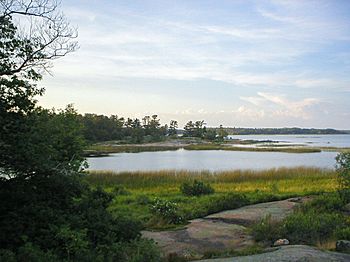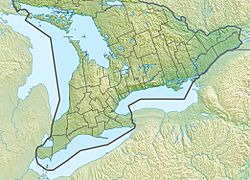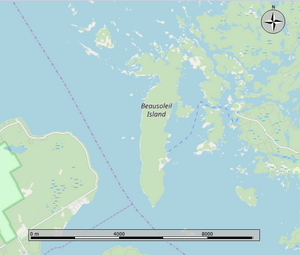Beausoleil Island facts for kids

The waters between Finger Point and Thumb Point near Cedar Springs, Beausoleil Island
|
|
| Geography | |
|---|---|
| Location | Georgian Bay |
| Coordinates | 44°52′12″N 79°52′06″W / 44.87000°N 79.86833°W |
| Archipelago | Thirty Thousand Islands |
| Length | 8 km (5 mi) |
| Administration | |
| Province | Ontario |
| District Municipality | District Municipality of Muskoka |
| Municipality | Georgian Bay |
| Additional information | |
| Time zone | |
| • Summer (DST) |
|
Beausoleil Island is a long island in Ontario, Canada. It is about 8 kilometers (5 miles) long. You can find it in Georgian Bay, which is part of Lake Huron. The island is close to Port Severn.
Beausoleil Island is the biggest island in Georgian Bay Islands National Park. It is also the only place in the park where you can go camping. This island is special because it is part of the Georgian Bay Littoral, a UNESCO Biosphere Reserve. This means it is an important area for both nature and people.
Contents
Amazing Nature on Beausoleil Island
Beausoleil Island is a safe home for the Eastern Massasauga rattlesnake. This is the only snake in Ontario whose bite could be dangerous to humans. But don't worry, they are rarely seen!
When the sun shines, the deep blue waters of Georgian Bay look amazing. They stand out against the light blue sky and the pink rocks of the Canadian Shield. You will also see the park's famous pine trees, shaped by the wind.
Different Environments on the Island
The northern part of Beausoleil Island has a lot of rock and wet areas. This environment is home to many different kinds of animals. It is a major breeding spot for amphibians, turtles, and snakes.
The southern part of the island has forests with many different types of trees. These forests are great examples of the woodlands found in this region.
A Look Back in Time: History of Beausoleil Island
People have lived on or visited Beausoleil Island for a very long time. Scientists have found old tools and pottery from as far back as 7,000 years ago. This shows that the island was likely used as a summer camp by early hunting and gathering groups.
Later, different groups also used the island. These included the Point Peninsula and Saugeen groups, and the Algonkian-speaking Odawa (or Ottawa) people. They left behind clues about their lives on the island.
The Ojibwe People and the Island
In 1842, descendants of the Ojibwe people from Lake Huron and Lake Simcoe settled on Beausoleil Island. However, the soil on the island was not good for farming. Because of this, the group moved to the Christian Islands in the 1850s. These islands had been set aside as a special reserve for them.
Even today, the Ojibwe residents of Christian Islands call themselves the Beausoleil First Nation. This shows their strong connection to Beausoleil Island.
Camping History
Beausoleil Island also played a big part in the start of summer camps in Ontario. Many years ago, several youth camps were located here. As of 2018, two YMCA Camps are still on the island: YMCA Camp Kitchikewana and YMCA Camp Queen Elizabeth. These camps have helped many young people learn and grow.
National Historic Site
In 2011, Beausoleil Island was named a National Historic Site of Canada. This means it is a very important place in Canadian history.
Fun Things to Do
Beausoleil Island is a great place to visit! You can enjoy:
- Camping in tents or cabins.
- Docking your boat overnight or for the day.
- Learning about the island's history and nature through special programs.
- Exploring many hiking trails.
The Cedar Spring campground even has sites that are easy to access for wheelchairs. You can also reserve campsites ahead of time.



